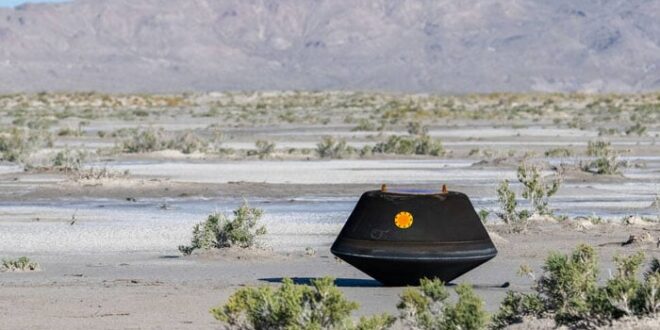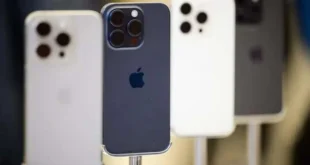Nasa’s Bennu asteroid sample collection mission has sent a chunk of an enormous space asteroid that may one day collide with Earth, allowing researchers to learn more about the formation of the solar system, a feat which the agency has never accomplished before.
The OSIRIS-REx spacecraft swung by Earth on Sunday, seven years after it was sent into orbit, to deliver the pristine sample from the nearby asteroid Bennu.
Origins, Spectral Interpretation, Resource Identification, Security and Regolith Explorer (OSIRIS-REx) was launched in 2016 and started orbiting Bennu in 2018. The sample was taken by the spacecraft in 2020, and it began its drawn-out journey back to Earth in May of 2021.
Early on Sunday, the spacecraft dropped the sample capsule from a height of 63,000 miles (102,000 kilometres) above Earth’s surface. The capsule contained an estimated 8.8 ounces of asteroid rocks and soil, and it entered the planet’s atmosphere at 10:42 am ET while travelling at a speed of about 27,650 miles per hour.
“Congratulations to the OSIRIS-REx team. You did it,” said Nasa administrator Bill Nelson. “It brought something extraordinary, the largest asteroid sample ever received on Earth. This mission proves that Nasa does big things, things that inspire us, things that unite us. It wasn’t mission impossible. It was the impossible that became possible,” reported CNN.
The solar system exploration mission OSIRIS-REx is still going strong. The spacecraft has already started to take a close look at another asteroid called Apophis.
OSIRIS-APEX, which stands for Origins, Spectral Interpretation, Resource Identification, Security-APophis EXplorer, is the new name of the mission.
According to Sandra Freund, OSIRIS-REx programme manager at Lockheed Martin Space, which collaborated with Nasa to develop the spacecraft, provideD flight operations, and assisted in recovering the 100-pound capsule. These teams had been practising for the event for months.
Given that the capsule’s temperature reached up to 5,000 degrees Fahrenheit (2,760 degrees Celsius) during reentry, the initial recovery team made sure it was cool enough to touch while wearing protective gloves and masks. The team also made sure that the capsule’s batteries wouldn’t malfunction and release any hazardous gases.
A science team took samples of the air, dust, and dirt from the landing site.
“One of the key scientific objectives of OSIRIS-REx is to return a pristine sample and pristine means that no foreign materials hamper our investigation during sample analysis,” said Dante Lauretta, OSIRIS-REx principal investigator at the University of Arizona in Tucson. “As unlikely as it is, we do want to make sure any materials that are out there in the Utah range that may interact with the sample are well documented.”
Since starting to work on the project almost twenty years ago, Lauretta can still clearly recall when it was first mentioned in a Nasa proposal. Lauretta was there at every stage of the process, including the assembly and attachment of the capsule to the spacecraft before to launch. He was among the first on Sunday to approach the capsule after it had landed to greet it.
“It was like seeing an old friend that you hadn’t seen for a long time,” he said. “I did want to give it a hug. One of the key moments for me was seeing it. I knew we had done it, that we had pulled it off. As incredible as it seemed all those years ago, it came to be.”
The sample was brought to a makeshift clean room close to the landing location by a helicopter while enclosed in a cargo net. A nitrogen flow, known as a purge, will be carried out within this area by the curation team to keep any of Earth’s atmosphere from entering the sample canister and polluting it. According to Nicole Lunning, OSIRIS-REx curation lead at Nasa’s Johnson Space Centre in Houston, the largest portions of the capsule will be removed.
On Monday, a group will get the sample canister ready for flight to Nasa’s Johnson Space Centre in Houston in a C-17 plane. On Tuesday, the scientists plan to open the cover and view the sample for the first time.
The recovery team will examine all of the video evidence of the descent to see if the drogue parachute, which was used to stabilise the capsule at first, deployed in a timely manner. The crew was unable to see any visual proof when it was supposed to be released. The primary parachute, which slows the capsule to a safe landing speed, also opened earlier than expected.
“But at the end of the day, when that main chute deployed, it basically corrected any of the sins that may have happened ahead of it,” said Tim Priser, chief engineer for deep space exploration at Lockheed Martin. “It touched down like a feather.”
On October 11, Nasa will webcast from Johnson Space Centre with information regarding the sample. The scientists intend to gather some fine-grained material from the top of the canister on Tuesday for a quick examination that can be given in October, even though they won’t have had enough time to completely evaluate the sample, according to Lauretta. According to him, the initial examination will check for the presence of minerals and chemical elements.
In a specialised clean room at Johnson Space Centre, researchers will examine the rocks and soil over the following two years. Additionally, the sample will be split up and distributed to other research facilities across the world, including collaborators in the OSIRIS-REx mission at the Canadian Space Agency and the Japanese Aerospace Exploration Agency. In order for future generations with improved technology to learn even more than what is currently attainable, about 70% of the sample will remain undamaged in storage.
 Speedinews Spreading Daily News With Speed
Speedinews Spreading Daily News With Speed




